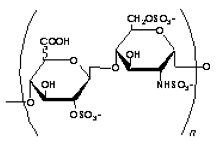Heparan sulfate
Heparan sulfates (HS) is a linear polysaccharide glycosaminoglycan (see Glycosaminoglycans) with attached sulfonate groups. It consists of repeating disaccharide units composed of hexuronic acid (D-glucuronic or L-iduronic) linked to N-glucosamine. The amino group of the latter can be acetylated or have a sulfonate group attached to it. Additionally, sulfonate groups can be attached to one of the hydroxyl groups. Heparan sulfate is found in the extracellular matrix of animals and is also part of the proteoglycans on the surface of all eukaryotic cells. It plays a crucial role as a regulator of cellular functions; by specifically binding to certain proteins (growth factors, extracellular matrix proteins, etc.) and pathogens, it is involved in physiological processes such as embryogenesis and pathological processes like inflammation, neurodegenerative diseases, angiogenesis, wound healing, cancer, cardiovascular diseases, and infectious diseases. Heparan sulfates covalently attach to proteins, forming heparan sulfate proteoglycans. These proteoglycans mostly contain three types of HS. Syndecans and glypicans are the most common HS-containing proteoglycans on the cell surface. They are important components of cell signaling systems on the cell or extracellular matrix surface. Perlecans are heparan sulfates mainly found in the extracellular matrix. Heparan sulfates accumulate in tissues during various mucopolysaccharidoses (see Mucopolysaccharidoses).

Source | Glossary of Most Commonly Used Biomedical Terms and Concepts | Lithuanian University of Health Sciences | Academician Professor Antanas Praškevičius, Professor Laima Ivanovienė
